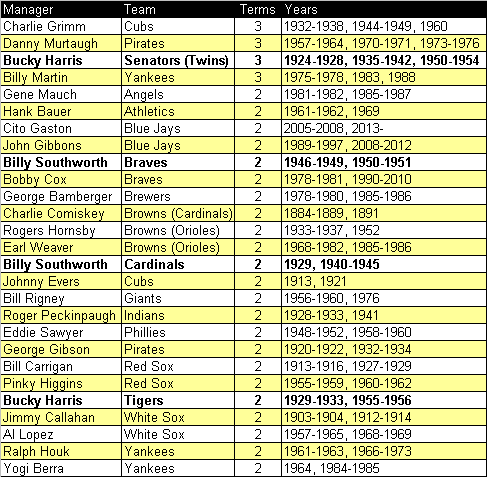The more things change, the more they stay the same. At least that seems to be the case in Toronto. Earlier in the week, the Blue Jays hired, or, more precisely, re-hired John Gibbons as manager. The former catcher had previously piloted the team from 2005 until the middle of 2008, when he was replaced by Cito Gaston, who was also making an encore appearance in Toronto.
When Gibbons manages on Opening Day, he will become the 32nd manager to begin two non-consecutive seasons at the helm of the same team (although believed to be exhaustive, this count is the result of a manual review of every team’s managerial history and, therefore, subject to an omission). This list, which would double if it included skippers who served on an interim basis at various points in the season, can be further whittled down by excluding those who had a consecutive tenure interrupted by health concerns (Birdie Tebbetts, Mickey Cochrane, Chuck Dressen, and Buck Rodgers), suspension (Leo Durocher) and ordinary shuffling of player/managers (John Morrill and Fred Tenney). The resultant list of 25 represents less than 4% of the 676 managers who have donned a major league uniform (or a suit, in the case of Connie Mack), putting Gibbons in select company.
Note: Terms refer to the number of tenures that included at least one Opening Day (i.e., manager started the season), and which was non-consecutive. Years refer to the entire period of the tenure, including mid-season stints and with no distinction made for absences due to extenuating circumstances.
Source: Baseball-reference.com
Before the Blue Jays made a habit of recycling managers, the last skipper to give an encore for the same organization was Bobby Cox, which is appropriate considering he also served as manager in Toronto in between his two stints at the helm of the Atlanta Braves. GM Alex Anthopoulos is probably hoping Gibbons’ return to the Blue Jays will be just as successful as Cox’ re-emergence in Atlanta. After an undistinguished run as manager from 1978 to 1981, Cox led the Braves to a first place finish in 14 of the 20 seasons during his second stint. Who said sequels are never better than the original?
Unfortunately, most managerial homecomings haven’t been very pleasant, regardless of stature. Two of the most successful managers of their era, Earl Weaver and Billy Martin, were both unable to rekindle their magic after leaving the helm of the Orioles and Yankees, respectively. Weaver’s return to Baltimore in 1985, three years removed from a 15-year run that landed him in the Hall of Fame, proved disappointing as the fiery skipper ended his career with a last place finish in 1986. During the same period, Martin was reprising his role as Yankees’ manager for the fifth time overall and third at the beginning of a non-consecutive season, joining Bucky Harris (Senators), Danny Murtaugh (Pirates) and Charlie Grimm (Cubs) as the only skippers to prove the third time is a charm (or, perhaps, not).
Harris also has the distinction of being one of two managers to have an encore with two different organizations. In addition to his three stints with the Senators, Harris, who managed five different teams and 4,410 games during his 29-year career, also led the Detroit Tigers from 1929-33 and 1955-1956. Billy Southworth’s happy return occurred with the St. Louis Cardinals and Boston Braves, but the circumstances behind each was very different. His reappearance with the Cardinals from 1940-1945 came 11 years after a brief stint as player/manager, whereas his return to the Braves came after a brief hiatus brought about by rumors of heavy drinking and a player revolt. Southworth, who took over as Braves’ manager in 1946, handed over the reigns to Johnny Cooney more than halfway through the 1949 season, but snatched them back in 1950 before finally relinquishing control in 1951.
The 22 years between Bucky Harris’ two stints as manager of the Tigers also distinguishes the Hall of Fame manager from his peers. The only other skipper with a gap of at least 20 years before returning to the same organization is Yogi Berra, who took over as manager of the Yankees in 1984, two decades after being fired following a pennant winning season in 1964. Despite an improved finish in 1984, Berra was again quickly dismissed only 16 games into the 1985 season. The Yankees’ hasty handling of Berra for a second time prompted another long separation, this time self-imposed, between the Hall of Famer and the franchise with which he won 10 World Series.
During his first go-round as manager in Toronto, John Gibbons had his share of dust-ups, but also enjoyed relative success, including an 87-win, second-place finish in 2006 that remains as the franchise’s best performance in nearly 15 years. So, although very few managers have had much success returning to their old haunts, maybe Gibbons’ second chance in Toronto will prove to be an exception? After all, if any city should know how to make a sequel, it’s the town that gave us Police Academy.




